Organization Behavior Report: X-Stream's Management Issues Analysis
VerifiedAdded on 2022/11/24
|7
|1622
|220
Report
AI Summary
This report analyzes the organizational behavior of X-Stream, a company facing internal management challenges. It identifies key symptoms such as poor communication, lack of managerial consensus, and an output-oriented approach. The report explores the application of organizational behavior theories, including contingency theory and the collegial model, to address these issues. Recommended actions include implementing autocratic leadership initially, followed by a participative approach, and establishing a flat organizational structure. The report also discusses the applicability of these concepts to another workplace, suggesting adjustments such as a participative managerial approach, vertical-horizontal structure, and clan culture. The conclusion emphasizes the importance of situational leadership and the potential of the discussed theories to improve X-Stream's long-term performance.
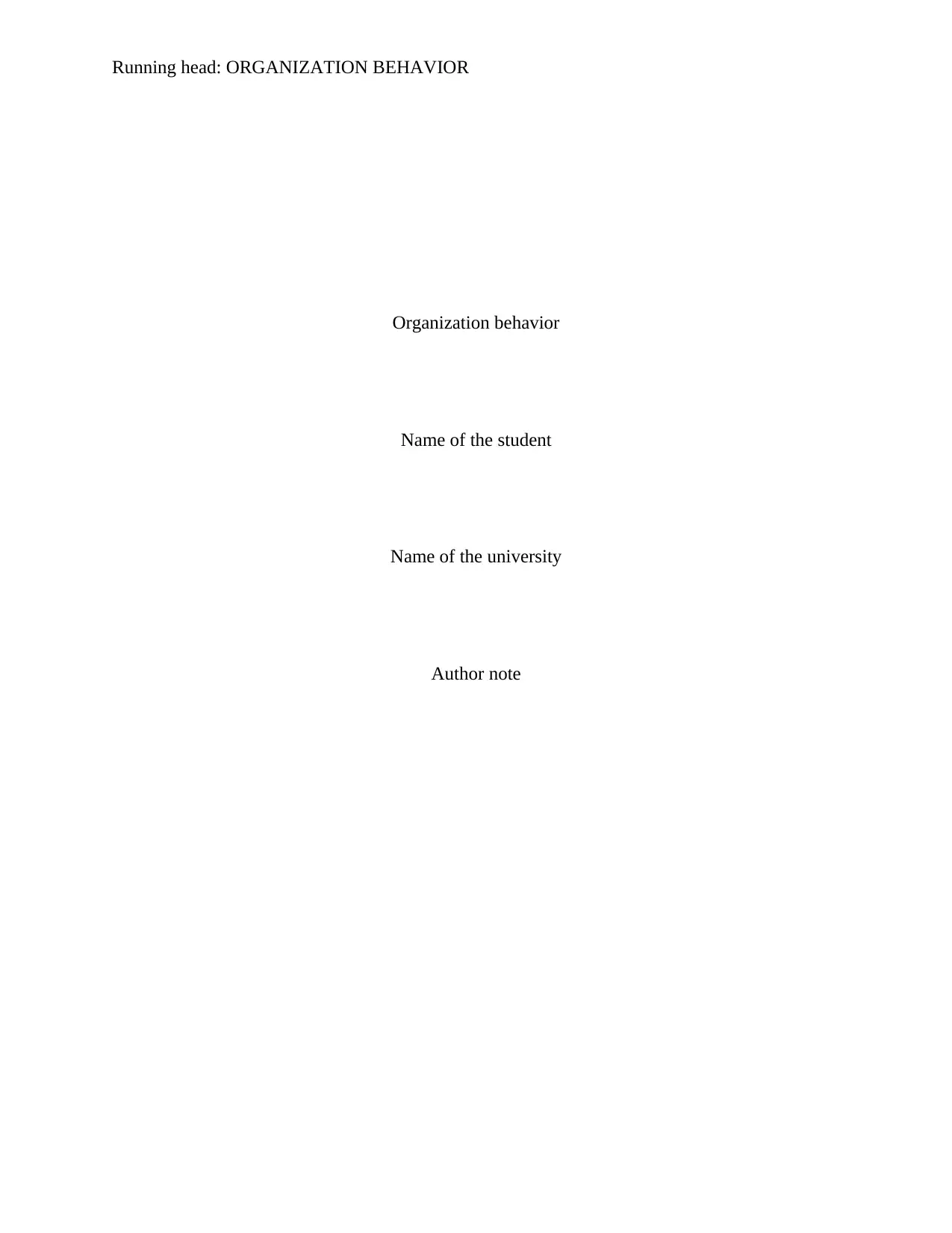
Running head: ORGANIZATION BEHAVIOR
Organization behavior
Name of the student
Name of the university
Author note
Organization behavior
Name of the student
Name of the university
Author note
Paraphrase This Document
Need a fresh take? Get an instant paraphrase of this document with our AI Paraphraser
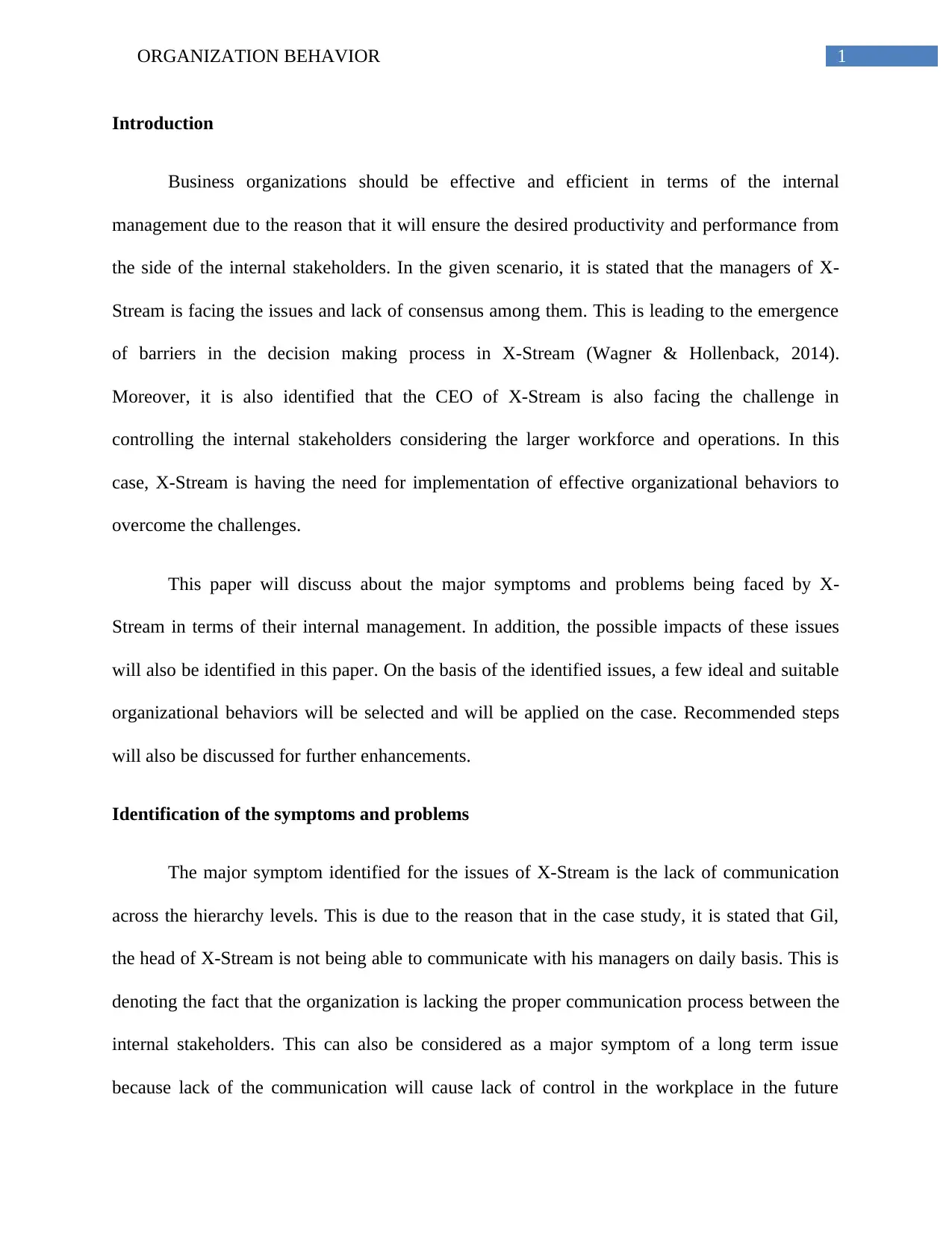
1ORGANIZATION BEHAVIOR
Introduction
Business organizations should be effective and efficient in terms of the internal
management due to the reason that it will ensure the desired productivity and performance from
the side of the internal stakeholders. In the given scenario, it is stated that the managers of X-
Stream is facing the issues and lack of consensus among them. This is leading to the emergence
of barriers in the decision making process in X-Stream (Wagner & Hollenback, 2014).
Moreover, it is also identified that the CEO of X-Stream is also facing the challenge in
controlling the internal stakeholders considering the larger workforce and operations. In this
case, X-Stream is having the need for implementation of effective organizational behaviors to
overcome the challenges.
This paper will discuss about the major symptoms and problems being faced by X-
Stream in terms of their internal management. In addition, the possible impacts of these issues
will also be identified in this paper. On the basis of the identified issues, a few ideal and suitable
organizational behaviors will be selected and will be applied on the case. Recommended steps
will also be discussed for further enhancements.
Identification of the symptoms and problems
The major symptom identified for the issues of X-Stream is the lack of communication
across the hierarchy levels. This is due to the reason that in the case study, it is stated that Gil,
the head of X-Stream is not being able to communicate with his managers on daily basis. This is
denoting the fact that the organization is lacking the proper communication process between the
internal stakeholders. This can also be considered as a major symptom of a long term issue
because lack of the communication will cause lack of control in the workplace in the future
Introduction
Business organizations should be effective and efficient in terms of the internal
management due to the reason that it will ensure the desired productivity and performance from
the side of the internal stakeholders. In the given scenario, it is stated that the managers of X-
Stream is facing the issues and lack of consensus among them. This is leading to the emergence
of barriers in the decision making process in X-Stream (Wagner & Hollenback, 2014).
Moreover, it is also identified that the CEO of X-Stream is also facing the challenge in
controlling the internal stakeholders considering the larger workforce and operations. In this
case, X-Stream is having the need for implementation of effective organizational behaviors to
overcome the challenges.
This paper will discuss about the major symptoms and problems being faced by X-
Stream in terms of their internal management. In addition, the possible impacts of these issues
will also be identified in this paper. On the basis of the identified issues, a few ideal and suitable
organizational behaviors will be selected and will be applied on the case. Recommended steps
will also be discussed for further enhancements.
Identification of the symptoms and problems
The major symptom identified for the issues of X-Stream is the lack of communication
across the hierarchy levels. This is due to the reason that in the case study, it is stated that Gil,
the head of X-Stream is not being able to communicate with his managers on daily basis. This is
denoting the fact that the organization is lacking the proper communication process between the
internal stakeholders. This can also be considered as a major symptom of a long term issue
because lack of the communication will cause lack of control in the workplace in the future
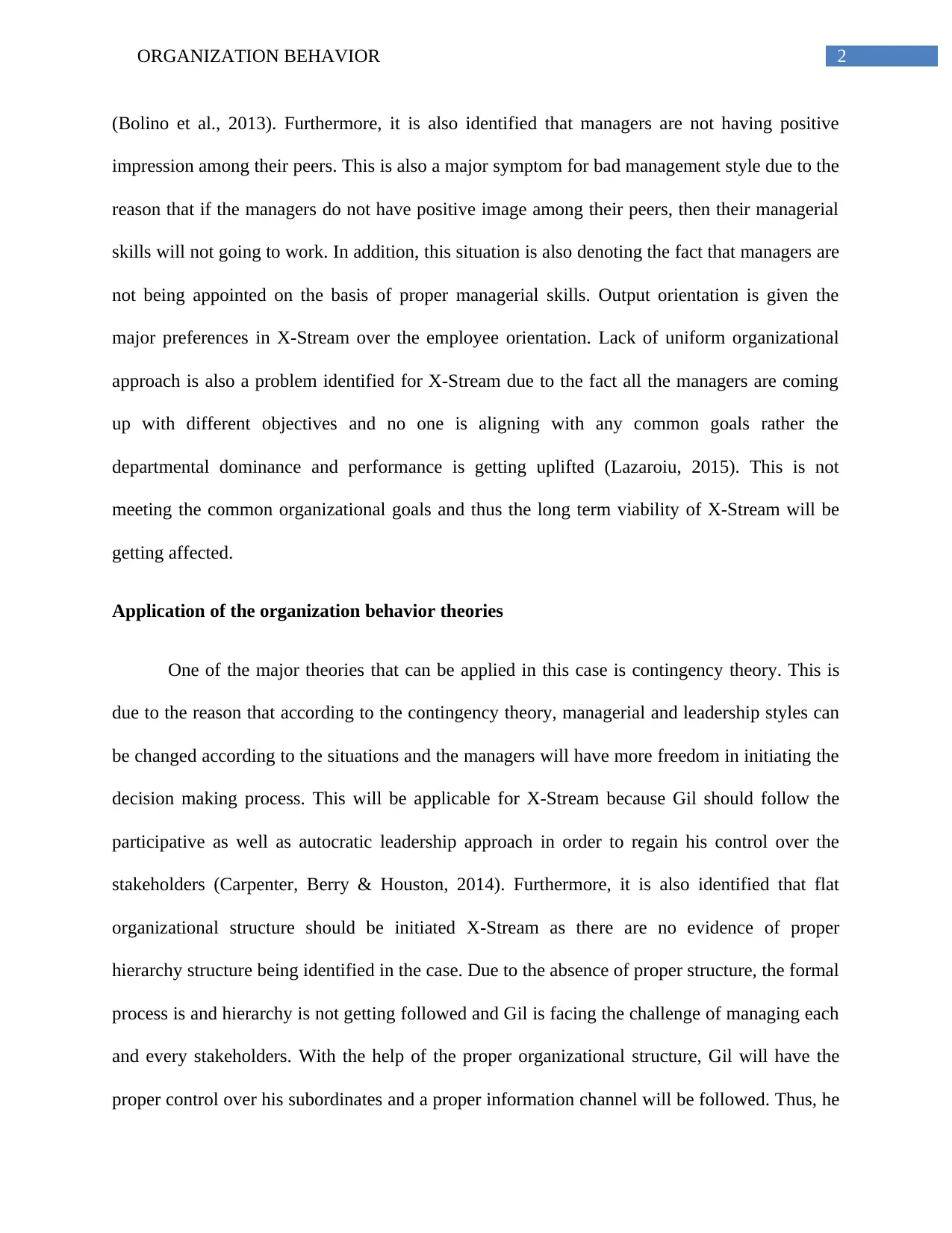
2ORGANIZATION BEHAVIOR
(Bolino et al., 2013). Furthermore, it is also identified that managers are not having positive
impression among their peers. This is also a major symptom for bad management style due to the
reason that if the managers do not have positive image among their peers, then their managerial
skills will not going to work. In addition, this situation is also denoting the fact that managers are
not being appointed on the basis of proper managerial skills. Output orientation is given the
major preferences in X-Stream over the employee orientation. Lack of uniform organizational
approach is also a problem identified for X-Stream due to the fact all the managers are coming
up with different objectives and no one is aligning with any common goals rather the
departmental dominance and performance is getting uplifted (Lazaroiu, 2015). This is not
meeting the common organizational goals and thus the long term viability of X-Stream will be
getting affected.
Application of the organization behavior theories
One of the major theories that can be applied in this case is contingency theory. This is
due to the reason that according to the contingency theory, managerial and leadership styles can
be changed according to the situations and the managers will have more freedom in initiating the
decision making process. This will be applicable for X-Stream because Gil should follow the
participative as well as autocratic leadership approach in order to regain his control over the
stakeholders (Carpenter, Berry & Houston, 2014). Furthermore, it is also identified that flat
organizational structure should be initiated X-Stream as there are no evidence of proper
hierarchy structure being identified in the case. Due to the absence of proper structure, the formal
process is and hierarchy is not getting followed and Gil is facing the challenge of managing each
and every stakeholders. With the help of the proper organizational structure, Gil will have the
proper control over his subordinates and a proper information channel will be followed. Thus, he
(Bolino et al., 2013). Furthermore, it is also identified that managers are not having positive
impression among their peers. This is also a major symptom for bad management style due to the
reason that if the managers do not have positive image among their peers, then their managerial
skills will not going to work. In addition, this situation is also denoting the fact that managers are
not being appointed on the basis of proper managerial skills. Output orientation is given the
major preferences in X-Stream over the employee orientation. Lack of uniform organizational
approach is also a problem identified for X-Stream due to the fact all the managers are coming
up with different objectives and no one is aligning with any common goals rather the
departmental dominance and performance is getting uplifted (Lazaroiu, 2015). This is not
meeting the common organizational goals and thus the long term viability of X-Stream will be
getting affected.
Application of the organization behavior theories
One of the major theories that can be applied in this case is contingency theory. This is
due to the reason that according to the contingency theory, managerial and leadership styles can
be changed according to the situations and the managers will have more freedom in initiating the
decision making process. This will be applicable for X-Stream because Gil should follow the
participative as well as autocratic leadership approach in order to regain his control over the
stakeholders (Carpenter, Berry & Houston, 2014). Furthermore, it is also identified that flat
organizational structure should be initiated X-Stream as there are no evidence of proper
hierarchy structure being identified in the case. Due to the absence of proper structure, the formal
process is and hierarchy is not getting followed and Gil is facing the challenge of managing each
and every stakeholders. With the help of the proper organizational structure, Gil will have the
proper control over his subordinates and a proper information channel will be followed. Thus, he
⊘ This is a preview!⊘
Do you want full access?
Subscribe today to unlock all pages.

Trusted by 1+ million students worldwide
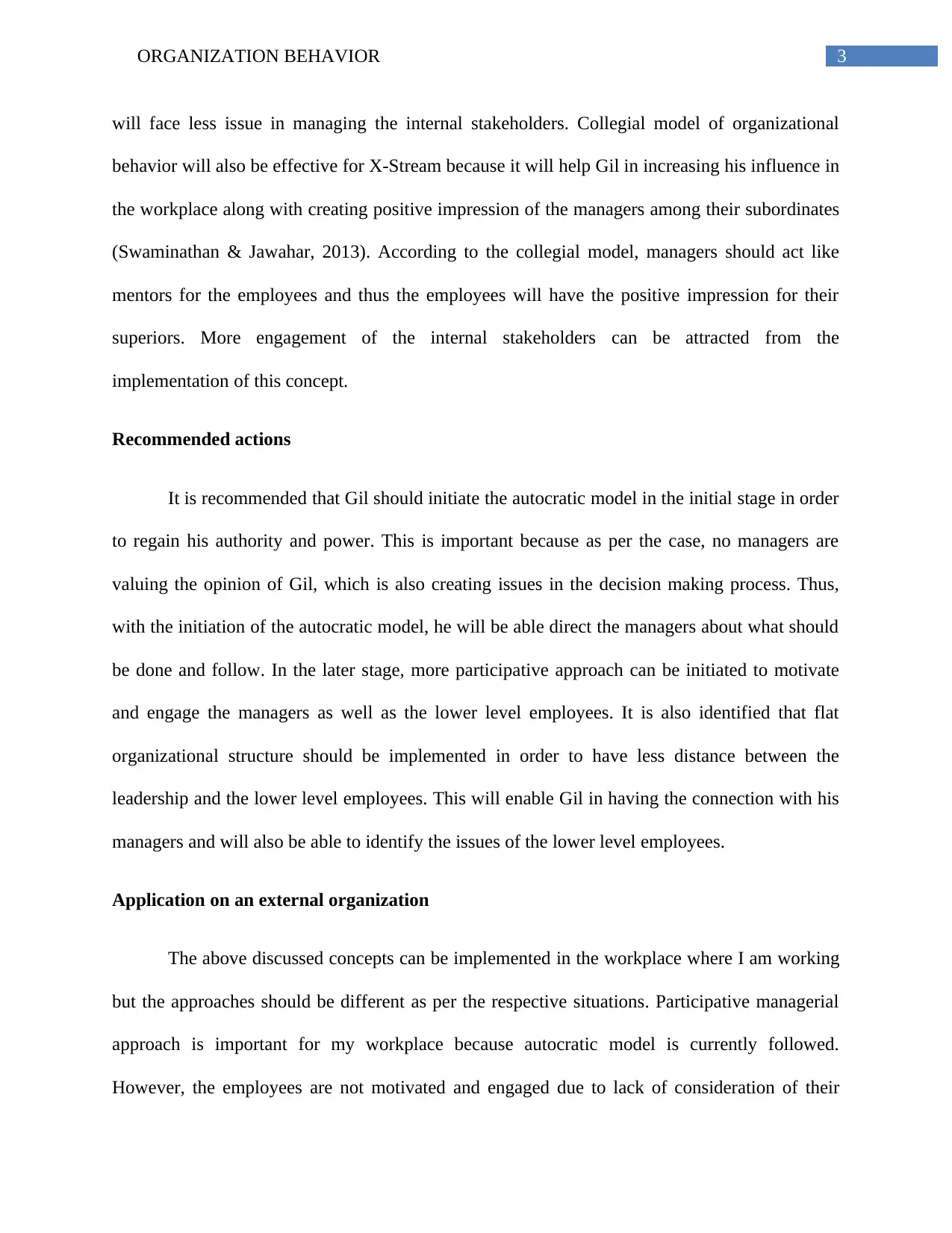
3ORGANIZATION BEHAVIOR
will face less issue in managing the internal stakeholders. Collegial model of organizational
behavior will also be effective for X-Stream because it will help Gil in increasing his influence in
the workplace along with creating positive impression of the managers among their subordinates
(Swaminathan & Jawahar, 2013). According to the collegial model, managers should act like
mentors for the employees and thus the employees will have the positive impression for their
superiors. More engagement of the internal stakeholders can be attracted from the
implementation of this concept.
Recommended actions
It is recommended that Gil should initiate the autocratic model in the initial stage in order
to regain his authority and power. This is important because as per the case, no managers are
valuing the opinion of Gil, which is also creating issues in the decision making process. Thus,
with the initiation of the autocratic model, he will be able direct the managers about what should
be done and follow. In the later stage, more participative approach can be initiated to motivate
and engage the managers as well as the lower level employees. It is also identified that flat
organizational structure should be implemented in order to have less distance between the
leadership and the lower level employees. This will enable Gil in having the connection with his
managers and will also be able to identify the issues of the lower level employees.
Application on an external organization
The above discussed concepts can be implemented in the workplace where I am working
but the approaches should be different as per the respective situations. Participative managerial
approach is important for my workplace because autocratic model is currently followed.
However, the employees are not motivated and engaged due to lack of consideration of their
will face less issue in managing the internal stakeholders. Collegial model of organizational
behavior will also be effective for X-Stream because it will help Gil in increasing his influence in
the workplace along with creating positive impression of the managers among their subordinates
(Swaminathan & Jawahar, 2013). According to the collegial model, managers should act like
mentors for the employees and thus the employees will have the positive impression for their
superiors. More engagement of the internal stakeholders can be attracted from the
implementation of this concept.
Recommended actions
It is recommended that Gil should initiate the autocratic model in the initial stage in order
to regain his authority and power. This is important because as per the case, no managers are
valuing the opinion of Gil, which is also creating issues in the decision making process. Thus,
with the initiation of the autocratic model, he will be able direct the managers about what should
be done and follow. In the later stage, more participative approach can be initiated to motivate
and engage the managers as well as the lower level employees. It is also identified that flat
organizational structure should be implemented in order to have less distance between the
leadership and the lower level employees. This will enable Gil in having the connection with his
managers and will also be able to identify the issues of the lower level employees.
Application on an external organization
The above discussed concepts can be implemented in the workplace where I am working
but the approaches should be different as per the respective situations. Participative managerial
approach is important for my workplace because autocratic model is currently followed.
However, the employees are not motivated and engaged due to lack of consideration of their
Paraphrase This Document
Need a fresh take? Get an instant paraphrase of this document with our AI Paraphraser
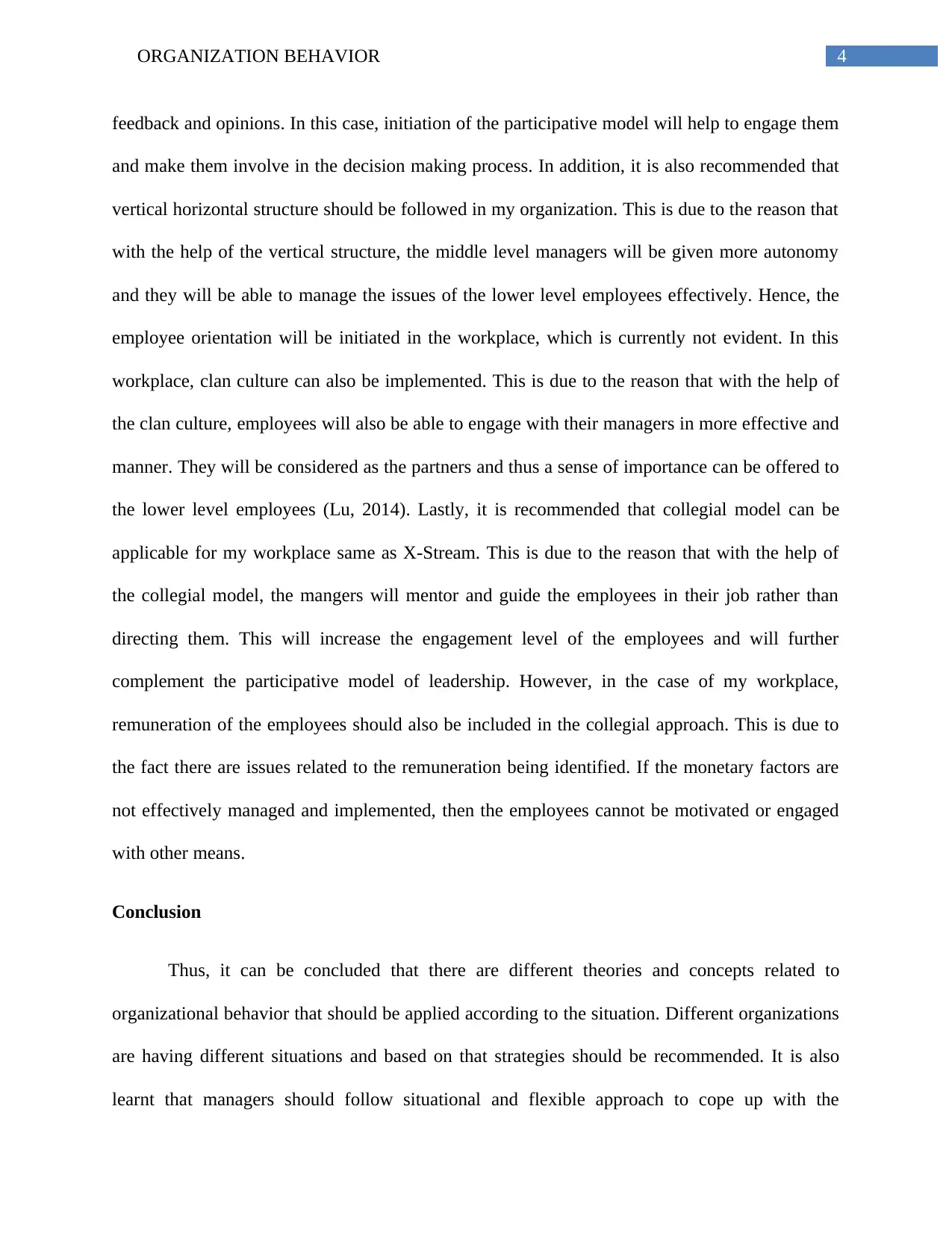
4ORGANIZATION BEHAVIOR
feedback and opinions. In this case, initiation of the participative model will help to engage them
and make them involve in the decision making process. In addition, it is also recommended that
vertical horizontal structure should be followed in my organization. This is due to the reason that
with the help of the vertical structure, the middle level managers will be given more autonomy
and they will be able to manage the issues of the lower level employees effectively. Hence, the
employee orientation will be initiated in the workplace, which is currently not evident. In this
workplace, clan culture can also be implemented. This is due to the reason that with the help of
the clan culture, employees will also be able to engage with their managers in more effective and
manner. They will be considered as the partners and thus a sense of importance can be offered to
the lower level employees (Lu, 2014). Lastly, it is recommended that collegial model can be
applicable for my workplace same as X-Stream. This is due to the reason that with the help of
the collegial model, the mangers will mentor and guide the employees in their job rather than
directing them. This will increase the engagement level of the employees and will further
complement the participative model of leadership. However, in the case of my workplace,
remuneration of the employees should also be included in the collegial approach. This is due to
the fact there are issues related to the remuneration being identified. If the monetary factors are
not effectively managed and implemented, then the employees cannot be motivated or engaged
with other means.
Conclusion
Thus, it can be concluded that there are different theories and concepts related to
organizational behavior that should be applied according to the situation. Different organizations
are having different situations and based on that strategies should be recommended. It is also
learnt that managers should follow situational and flexible approach to cope up with the
feedback and opinions. In this case, initiation of the participative model will help to engage them
and make them involve in the decision making process. In addition, it is also recommended that
vertical horizontal structure should be followed in my organization. This is due to the reason that
with the help of the vertical structure, the middle level managers will be given more autonomy
and they will be able to manage the issues of the lower level employees effectively. Hence, the
employee orientation will be initiated in the workplace, which is currently not evident. In this
workplace, clan culture can also be implemented. This is due to the reason that with the help of
the clan culture, employees will also be able to engage with their managers in more effective and
manner. They will be considered as the partners and thus a sense of importance can be offered to
the lower level employees (Lu, 2014). Lastly, it is recommended that collegial model can be
applicable for my workplace same as X-Stream. This is due to the reason that with the help of
the collegial model, the mangers will mentor and guide the employees in their job rather than
directing them. This will increase the engagement level of the employees and will further
complement the participative model of leadership. However, in the case of my workplace,
remuneration of the employees should also be included in the collegial approach. This is due to
the fact there are issues related to the remuneration being identified. If the monetary factors are
not effectively managed and implemented, then the employees cannot be motivated or engaged
with other means.
Conclusion
Thus, it can be concluded that there are different theories and concepts related to
organizational behavior that should be applied according to the situation. Different organizations
are having different situations and based on that strategies should be recommended. It is also
learnt that managers should follow situational and flexible approach to cope up with the
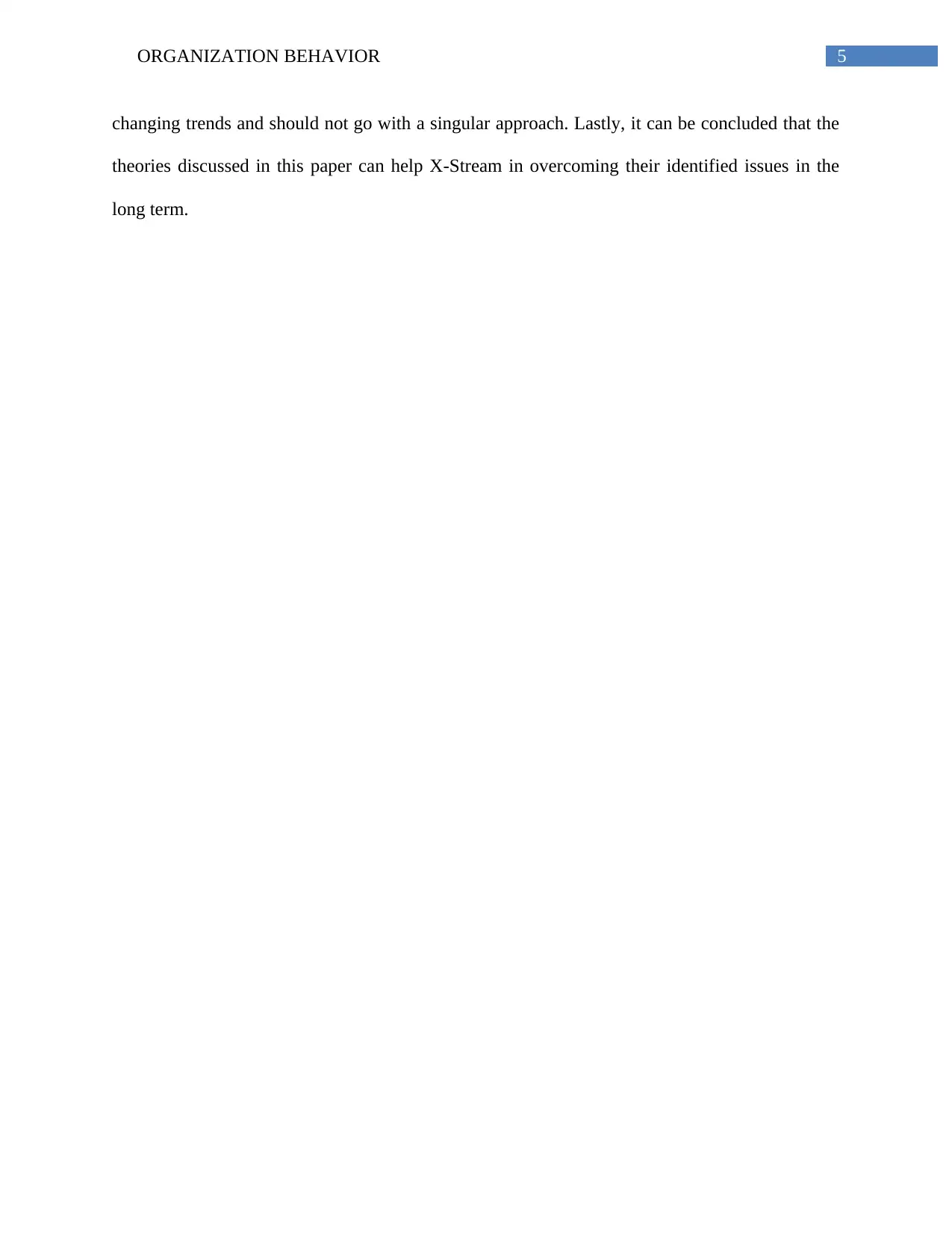
5ORGANIZATION BEHAVIOR
changing trends and should not go with a singular approach. Lastly, it can be concluded that the
theories discussed in this paper can help X-Stream in overcoming their identified issues in the
long term.
changing trends and should not go with a singular approach. Lastly, it can be concluded that the
theories discussed in this paper can help X-Stream in overcoming their identified issues in the
long term.
⊘ This is a preview!⊘
Do you want full access?
Subscribe today to unlock all pages.

Trusted by 1+ million students worldwide
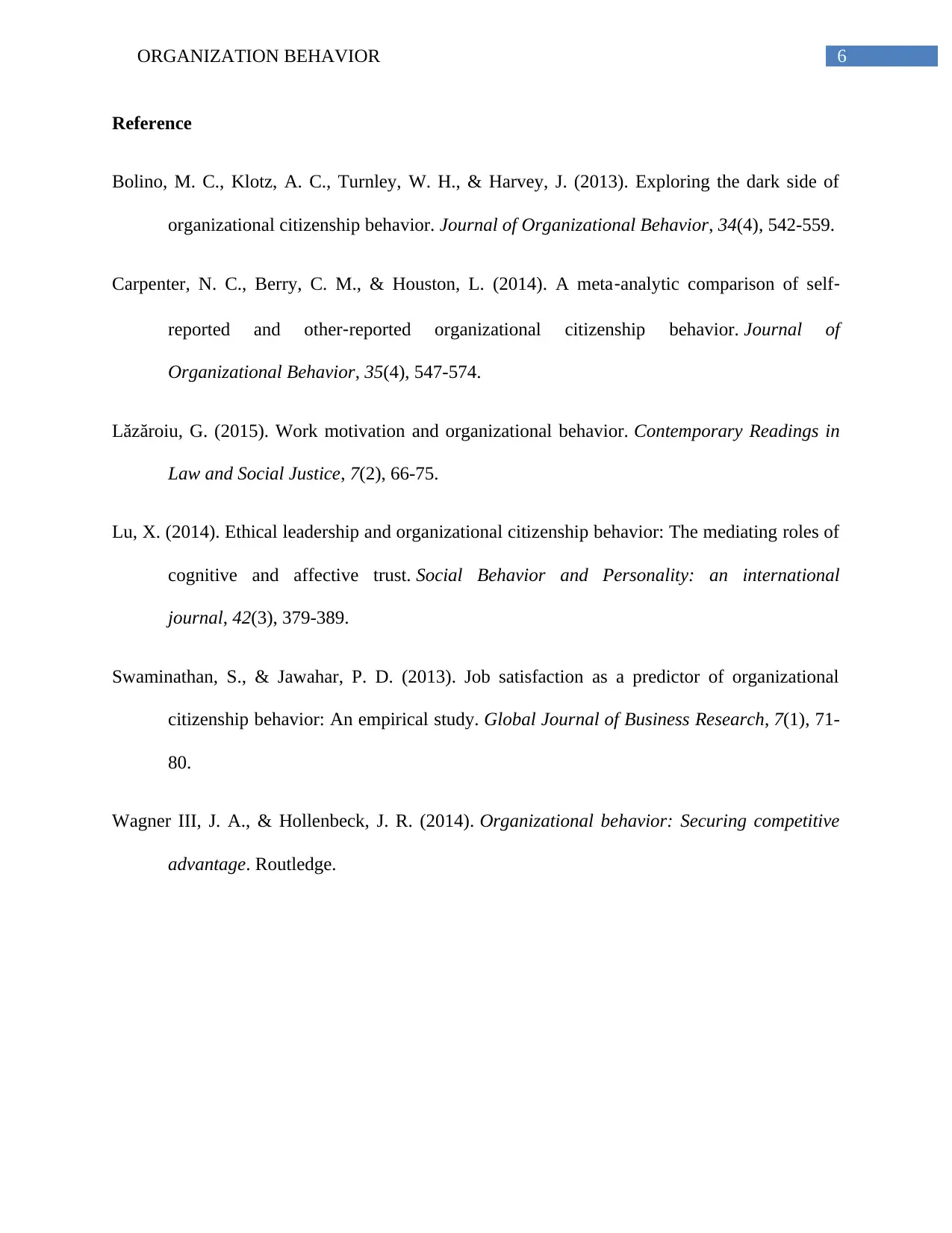
6ORGANIZATION BEHAVIOR
Reference
Bolino, M. C., Klotz, A. C., Turnley, W. H., & Harvey, J. (2013). Exploring the dark side of
organizational citizenship behavior. Journal of Organizational Behavior, 34(4), 542-559.
Carpenter, N. C., Berry, C. M., & Houston, L. (2014). A meta‐analytic comparison of self‐
reported and other‐reported organizational citizenship behavior. Journal of
Organizational Behavior, 35(4), 547-574.
Lăzăroiu, G. (2015). Work motivation and organizational behavior. Contemporary Readings in
Law and Social Justice, 7(2), 66-75.
Lu, X. (2014). Ethical leadership and organizational citizenship behavior: The mediating roles of
cognitive and affective trust. Social Behavior and Personality: an international
journal, 42(3), 379-389.
Swaminathan, S., & Jawahar, P. D. (2013). Job satisfaction as a predictor of organizational
citizenship behavior: An empirical study. Global Journal of Business Research, 7(1), 71-
80.
Wagner III, J. A., & Hollenbeck, J. R. (2014). Organizational behavior: Securing competitive
advantage. Routledge.
Reference
Bolino, M. C., Klotz, A. C., Turnley, W. H., & Harvey, J. (2013). Exploring the dark side of
organizational citizenship behavior. Journal of Organizational Behavior, 34(4), 542-559.
Carpenter, N. C., Berry, C. M., & Houston, L. (2014). A meta‐analytic comparison of self‐
reported and other‐reported organizational citizenship behavior. Journal of
Organizational Behavior, 35(4), 547-574.
Lăzăroiu, G. (2015). Work motivation and organizational behavior. Contemporary Readings in
Law and Social Justice, 7(2), 66-75.
Lu, X. (2014). Ethical leadership and organizational citizenship behavior: The mediating roles of
cognitive and affective trust. Social Behavior and Personality: an international
journal, 42(3), 379-389.
Swaminathan, S., & Jawahar, P. D. (2013). Job satisfaction as a predictor of organizational
citizenship behavior: An empirical study. Global Journal of Business Research, 7(1), 71-
80.
Wagner III, J. A., & Hollenbeck, J. R. (2014). Organizational behavior: Securing competitive
advantage. Routledge.
1 out of 7
Related Documents
Your All-in-One AI-Powered Toolkit for Academic Success.
+13062052269
info@desklib.com
Available 24*7 on WhatsApp / Email
![[object Object]](/_next/static/media/star-bottom.7253800d.svg)
Unlock your academic potential
Copyright © 2020–2025 A2Z Services. All Rights Reserved. Developed and managed by ZUCOL.





